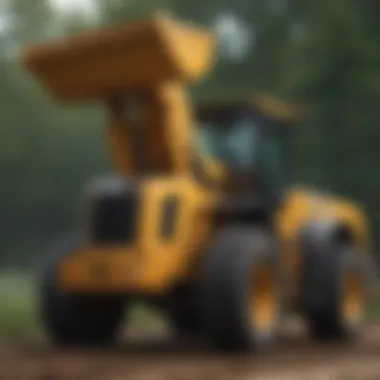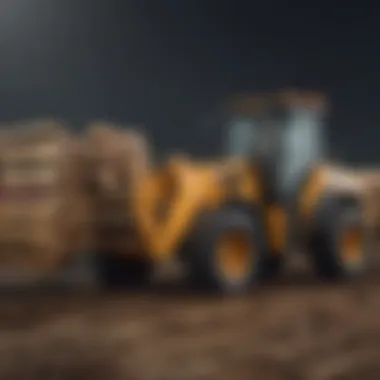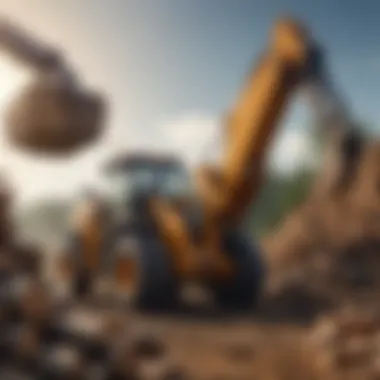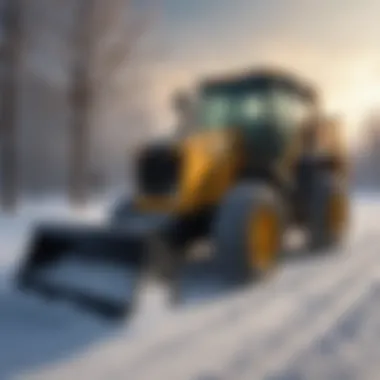Essential Front End Loader Accessories for Performance


Intro
In the ever-evolving landscape of agriculture and construction, the efficiency of equipment is paramount. Among these essential tools, front end loaders stand out for their versatility and capability. However, the true potential of these machines can only be unlocked with the right accessories. Accessories for front end loaders are not mere add-ons; they are transformative tools that improve functionality, operational efficiency, and productivity. This article seeks to explore the various accessories that enhance front end loaders, offering insights into their applications in farming and construction settings.
Each accessory is designed with a specific function in mind, addressing various challenges operators face in their day-to-day operations, whether that involves moving soil, lifting loads, or managing tasks in tight spaces. Therefore, understanding these accessories is crucial for maximizing performance.
Preface to Front End Loaders
Front end loaders are integral machines in both agricultural and construction sectors. Their ability to move large volumes of materials quickly makes them indispensable. Understanding the functionalities and applications of front end loaders is crucial for operators aiming to optimize efficiency. This section introduces the topic, discussing key elements, benefits, and considerations regarding the use and accessories of front end loaders.
Functionality of Front End Loaders
The core functionality of front end loaders is to lift, carry, and transport materials. These machines are equipped with a large bucket attached to the front, allowing them to perform various tasks with ease. Operators can use them to load soil, gravel, and other materials onto trucks or other machinery. The mechanics of the loader consist of hydraulic systems that enable smooth lifting and lowering of loads. This capability to handle materials efficiently is one reason why they are essential on construction sites and farms alike.
Additionally, their versatility is enhanced by the wide range of attachments available, making loaders adaptable to various tasks and work environments. Thus, understanding their functionality helps in choosing the right attachments and optimizing performance.
Importance in Agriculture and Construction
Front end loaders hold significant importance in both agriculture and construction. In agriculture, these machines facilitate numerous tasks like digging, lifting bales, or loading feed. Their use reduces labor time and enhances productivity, allowing farmers to focus more on cultivation than on manual labor. Consequently, this capability leads to better yields and efficient resource management.
In the construction field, front end loaders are crucial for moving materials like sand, concrete, and debris. They support faster project completions and improve safety by minimizing manual handling of heavy materials. Their presence often translates to reduced labor costs and increased overall productivity on job sites.
Moreover, the adaptability of front end loaders to various attachments allows for specialized applications, further underlining their importance in modern agricultural and construction practices.
The efficiency of front end loaders directly correlates with project success in construction and improved productivity in agriculture.
In summary, this section articulates not only the functionality of front end loaders but also their relevance in shaping efficient operations in both agriculture and construction. Understanding these elements prepares operators to make informed decisions about utilizing their capabilities effectively.
Understanding Front End Loader Accessories
Understanding front end loader accessories is crucial for maximizing the operational efficiency and effectiveness of loader machines. These accessories enhance the loader's capabilities, making them adaptable to various tasks in agriculture and construction. A well-selected accessory not only improves productivity but can also save time and labor costs, making it an essential consideration for any operator.
Types of Accessories
Buckets
Buckets are the most common attachments for front end loaders. Their primary function is to move materials such as soil, gravel, or debris. A key characteristic of buckets is their versatility. They come in multiple shapes and sizes, making them suitable for different tasks depending on the material being handled.
The unique feature of buckets is their design, which can range from general-purpose to specialized configurations like high capacity or light material buckets. General-purpose buckets are ideal for a wide range of jobs, while high capacity buckets fit well in bulk handling situations. However, improper bucket choice can lead to inefficiencies or damage, thus careful selection is vital.
Forks
Forks serve a different but equally important purpose. These attachments are designed primarily for lifting and transporting palletized loads. A notable feature of forks is their ability to pick up heavy items quickly, which can significantly streamline workflows on job sites.
An advantage of using forks is their efficiency in moving large loads, reducing the need for manual labor or additional equipment. However, operators need to be aware that improper usage can lead to accidents or damage as forks have specific weight limits that shouldn’t be exceeded.
Attachments for Specialized Tasks
This category includes various tools designed for specific tasks, such as grapple attachments for handling debris or stump grinders for tree clearing. The key characteristic here is specialization. These attachments enhance the loader’s functionality to handle unique challenges effectively.
One significant advantage of these specialized attachments is their ability to tackle tasks that standard buckets or forks cannot perform. However, specialized attachments can often be more expensive, and not all loaders may be compatible, requiring careful assessment before purchase.
Selecting the Right Accessory
Selecting the right accessory is essential to ensure the loader is equipped for its intended tasks. Making informed choices can optimize resource utilization and lead to successful project outcomes.
Assessing Project Requirements
Assessing project requirements involves identifying the specific tasks that will be undertaken with the loader. This aspect is fundamental as it allows operators to choose the most suitable accessories. Each project may have different needs based on factors like material type and site conditions.


The striking feature of assessing project requirements is that it helps prevent overspending on unnecessary tools. By understanding what is truly needed, operators can ensure they choose attachments that align well with their operational goals.
Evaluating Equipment Compatibility
Evaluating equipment compatibility is about ensuring that selected accessories will fit and work effectively with the loader. Each model of loader may have different specifications, including size and weight limits. A key characteristic in this aspect is the loader's hydraulic system design, which can impact the performance of certain attachments.
Compatibility ensures that attachments function correctly without risk of damage to either the loader or the accessory. Failing to evaluate compatibility can not only lead to wasted investments but also safety hazards on the worksite. Hence, it is a critical step in obtaining accessories for front end loaders.
Bucket Attachments
Bucket attachments are among the most essential accessories for front end loaders, significantly enhancing their functionality and adaptability across various tasks in agriculture and construction. These attachments come in various designs, tailored for specific operations, thereby improving the machine's efficiency and productivity. Understanding the different types of bucket attachments and their unique applications is crucial for operators aiming to maximize the potential of their front end loaders.
General Purpose Buckets
General purpose buckets are versatile tools used in a vast array of tasks. They are designed to handle a mixture of materials, making them suitable for loading, lifting, and moving earth, gravel, and other aggregates. One of the primary benefits of general purpose buckets is their adaptability. They can be used for tasks ranging from grading and backfilling to landscaping and waste removal.
When selecting a general purpose bucket, operators should consider factors such as the size and weight of the targeted material. For instance, a wider bucket can hold more volume, which may be beneficial in larger jobs, but it can reduce maneuverability in confined spaces. Operators should also check the compatible attachments for their front end loader model to ensure efficient operation.
High Capacity Buckets
High capacity buckets are specifically designed for handling larger loads. These buckets provide greater volume to accommodate heavier materials without compromising performance. For agricultural operations requiring the transportation of soil or feed, high capacity buckets can streamline these tasks, reducing the number of trips needed to complete a job.
Using high capacity buckets can lead to significant time and labor savings. However, it is essential to understand the limits of the front end loader's lifting capacity to avoid potential damage. Operators must be cautious and ensure that they do not exceed the manufacturer's stated weight limits, as this can lead to mechanical failure or accidents.
Light Material Buckets
Light material buckets are engineered for handling lighter, bulkier materials like mulch, snow, or light gravel. These buckets are shallower and wider, increasing their capacity for expansive materials while maintaining stability. Using a light material bucket can greatly enhance productivity in tasks like landscaping or snow removal where material density is less critical.
When choosing a light material bucket, consider the material types and their characteristics. Proper matching of attachments can prevent spills and improve workflow. Operators may also find it advantageous to adjust the loader settings to enhance performance when using these specialized buckets.
Tip: Always ensure that the bucket attachment suits the task. A mismatched attachment can lead to inefficiencies and increased wear and tear on the loader.
In summary, bucket attachments elevate the functionality of front end loaders in diverse settings. By understanding the different types—general purpose, high capacity, and light material buckets—operators can make informed choices, optimizing performance in their agricultural or construction projects.
Fork Attachments
Fork attachments are essential tools for maximizing the performance of front end loaders. They serve a distinct purpose by allowing operators to handle materials efficiently, which is crucial in both agricultural and construction settings. This section examines specific types of fork attachments, highlights their benefits, and discusses important considerations when selecting these tools for various tasks.
Pallet Forks
Pallet forks are one of the most commonly used types of fork attachments for front end loaders. They facilitate the lifting and transporting of heavy loads, especially on pallets. This is particularly beneficial in warehouses, farms, and construction sites where materials are often stacked and need to be moved quickly. Pallet forks enable users to handle materials such as boxes, crates, and even bulk items with precision.
The versatility of pallet forks is reflected in their capability to adjust to different load sizes. Many models allow for the spacing of fork tines to vary, accommodating for various pallet widths or materials that do not come in standard sizes. This adaptability is a significant advantage in optimizing workflow and minimizing downtime.
When choosing pallet forks, consider the following:
- Load Capacity: Ensure that the forks can handle the weight of materials being lifted.
- Length: Longer forks might be necessary for more substantial items but could affect the maneuverability of the loader.
- Compatibility: Verify that the forks fit the mounting system of your loader.
With the proper selection, pallet forks can significantly enhance productivity, ultimately leading to increased operational efficiency.
Bale Forks
Bale forks are specialized attachments designed for lifting and transporting round or square bales of hay, straw, and other agricultural products. Their unique shape allows for easy penetration into the bales while the design reduces damage, ensuring that the materials remain intact during handling.
In the agricultural sector, bale forks are indispensable during harvest seasons when efficient movement of bales is critical. They allow farmers to load and transport hay bales quickly to feed livestock or store them safely.


Critical considerations when selecting bale forks include:
- Tine Length and Shape: This affects how well the forks can grip the bales. A proper design ensures stability during transportation.
- Construction Quality: Since bale handling can involve heavy weights, ensure that the forks are made from durable materials that can withstand frequent use.
- Loader Compatibility: Just like with pallet forks, a good fit with your loader’s attachment system is essential to safety and performance.
By investing in quality bale forks, users can streamline their operations and significantly reduce manual labor.
Specialized Attachments
Specialized attachments for front end loaders enhance productivity by allowing a single machine to perform multiple tasks. In many agriculture and construction applications, the efficient use of a front end loader is critical for optimizing workflow. These attachments enable operators to tackle a variety of functions, often enhancing performance and reducing the need for additional equipment.
Grapple Attachments
Grapple attachments are vital when handling large or bulky materials. They are designed to grip, lift, and move heavy loads such as logs, rocks, or debris with precision. The dual-claw design provides better control compared to a standard bucket. This allows the operator to work in tighter spaces or uneven terrain, which is common in farming and forestry operations.
Key benefits of grapple attachments include:
- Increased Efficiency: Operators can load and unload materials much faster than manual methods.
- Versatility: Useful for various applications, from landscaping to demolition.
- Reduction of Damage: The ability to gently handle materials reduces the risk of damage to the load and surrounding areas.
Operators should consider the weight capacity and size of the grapple based on the loader's specifications to ensure compatibility.
Stump Grinders
Stump grinders are indispensable for land clearing and maintenance. They can efficiently remove tree stumps after logging or landscaping projects. This attachment grinds the stump down into small pieces, eliminating the need for heavy manual labor.
Factors to keep in mind regarding stump grinders include:
- Power Requirements: Different stump grinders operate on varying horsepower levels, requiring coordination with the loader’s capabilities.
- Cutting Depth Variability: Some models allow adjustable cutting depths, making them suitable for various sizes of stumps.
- Operator Skill: Proper training is necessary to safely and effectively use this attachment to avoid accidents or equipment damage.
Snow Plows and Blades
Snow plows and blades form an essential part of winter operations. They enable front end loaders to remove snow quickly and efficiently, keeping pathways and roads clear. This is especially important in agricultural settings where access to fields or barns must remain unobstructed during snow periods.
Benefits of using snow plows and blades include:
- Speed of Service: Front end loaders can clear large areas of snow far more rapidly than manual methods.
- Adjustability: Many blades can be angled or adjusted to different heights, allowing for effective clearing based on snow depth and surface.
- Durability: Most plows are engineered with materials designed to withstand harsh winter conditions, promising longevity in use.
Overall, specialized attachments significantly enhance the functionality of front end loaders, each serving unique purposes that cater to specific tasks. Proper selection and maintenance of these attachments streamline work processes and contribute positively to project outcomes.
Maintenance of Loader Accessories
Maintenance of loader accessories is critical for ensuring the longevity and effectiveness of these essential tools. Proper maintenance not only enhances performance but also guarantees safety during operation. Regular care reduces the likelihood of breakdowns and costly repairs, ultimately contributing to better operational efficiency.
Regular Inspection Procedures
Conducting regular inspections is vital to preserve the functionality of loader accessories. A structured inspection regimen allows operators to identify potential issues before they escalate. Key areas to focus on include:
- Structural Integrity: Check for any visible signs of damage or wear on buckets and forks. Any deformity should be addressed immediately.
- Hydraulic System: Examine the hydraulic connections for leaks and damaged hoses. The hydraulic system is crucial for the performance of many attachments.
- Cost of Repairs: Consider the financial implications of ignoring small issues. Early detection can save significant costs down the line.
Employing a checklist can assist in standardizing inspections. This checklist should include every accessory on the loader, outlining checks for wear, cleanliness, and functionality.
Cleaning and Maintenance Tips
Cleaning is often overlooked but is an essential part of maintenance. Good cleaning practices help to prevent rust and buildup of dirt, which can affect the performance of accessories. Here are some tips for effective cleaning:
- Routine Wash Downs: After operations, wash attachments thoroughly. Use high-pressure water to remove mud and debris.
- Greasing Moving Parts: Ensure that all moving parts are properly greased. This prevents excessive wear and tear.
- Store Properly: When not in use, store attachments in dry areas. Protect them from the elements and consider using protective covers.


"A little maintenance goes a long way in extending the life of your equipment."
Overall, systematic maintenance and cleaning practices can dramatically enhance the performance of loader accessories. Neglecting these responsibilities can lead to decreased efficiency and higher operational costs.
Economic Considerations
Understanding the economic implications of front end loader accessories is essential for maximizing performance and ensuring a sound investment. The choice of accessories impacts not only productivity but also the overall cost of operations. Therefore, evaluating the financial aspects associated with different attachments is a fundamental part of decision making. This section delves into cost considerations and their relevance in optimizing loader operations, providing practical insights for both agricultural users and construction professionals.
Cost-Benefit Analysis of Accessories
A cost-benefit analysis of front end loader accessories helps users determine the value each attachment brings to their specific tasks. Evaluating costs involves considering both direct and indirect expenses associated with purchasing, maintaining, and using the accessories. Here are key points to consider:
- Initial Purchase Cost: The primary consideration for any accessory. Higher quality attachments may cost more initially, but they could offer increased durability and efficiency over time.
- Operational Efficiency: Accessories that enhance operational speed or reduce man-hours can significantly offset their initial cost. For example, a high-capacity bucket could enable quicker loading and unloading, leading to time savings in the long run.
- Maintenance Costs: Regular maintenance is essential, and different accessories come with varying upkeep requirements. Choosing attachments that are easy and cheap to maintain can lower overall costs.
- Resale Value: Some accessories hold their value better than others. When upgrading equipment, understanding the resale market can lead to better economic outcomes.
"Investing in the right accessories is akin to investing in your own productivity. A thorough analysis ensures you make informed decisions."
By weighing these factors, users can ascertain if the added costs of specific attachments align with expected performance improvements and operational efficiency gains.
Long-Term Investment Value
When considering front end loader accessories, it's crucial to view them not just as short-term purchases, but as long-term investments. The right tools can dramatically extend the loader's versatility and life span. Here’s how:
- Versatility of Use: Accessories designed for multipurpose use allow for greater range in tasks. For instance, a grapple attachment on a loader can be used for both moving materials and clearing land. This adaptability can stretch the investment far beyond its original intention.
- Enhanced Performance Over Time: Premium accessories can provide better results over extended periods. Quality attachments resist wear and tear, providing functionality that endures the rigors of heavy use.
- Increased Resale Value: Attachments that are well-maintained and in high demand can fetch good resale prices. This potential return on investment should be factored into initial purchasing decisions.
- Reduced Downtime: Accessories that foster greater efficiency often lead to reduced downtime. Improved productivity translates into more completed projects, which can significantly affect profitability in competitive markets.
Future Trends in Loader Accessories
The landscape of front end loader accessories is evolving rapidly, reflecting the demands for efficiency, sustainability, and cost-effectiveness in agriculture and construction. This section will highlight crucial future trends shaping the development and utilization of loader accessories. Adapting to technological advancements and environmental considerations is vital for ensuring that these tools remain relevant and effective in meeting contemporary challenges.
Technological Innovations
As industries strive for improved productivity, technological innovations play a significant role in developing loader accessories. Smart technology integrated into these attachments enhances functionalities. For instance, GPS and telematics are now being incorporated into front end loaders. This technology facilitates real-time tracking of the loader's location and performance metrics. Such data can lead to more informed decisions regarding equipment usage, ultimately minimizing downtime and optimizing operational efficiency.
Another critical advancement is the rise of automation through the use of robotics. Automated attachments can perform tasks like material handling without extensive operator input. This feature not only reduces labor costs but also enhances precision and safety in operations. Moreover, the development of adaptable accessories that can change configurations based on the tasks at hand is becoming common. This versatility allows operators to switch tools without significant delays, keeping projects on schedule.
"Integration of technology into loader attachments is not just optional anymore; it is a necessity for modern agricultural and construction practices."
Sustainability in Accessory Design
Sustainability is another pressing concern influencing the design of loader accessories. As industries respond to environmental challenges, efforts to create eco-friendly equipment are increasing. Innovations such as lightweight materials for construction and biodegradable components are gaining traction. These sustainable materials not only reduce the environmental footprint associated with production and disposal but often enhance efficiency as well.
In addition, manufacturers are beginning to implement designs that minimize energy consumption. Accessory designs that utilize hydraulics more effectively can lead to significant fuel savings. Adopting practices such as electric-powered attachments instead of their diesel counterparts has become more prevalent. Embracing sustainable practices not only addresses regulatory requirements but also appeals to environmentally conscious customers.
The End
The conclusion of this article is critical as it synthesizes the information about essential front-end loader accessories, presenting it in a clear and concise manner. Understanding the significance of these accessories helps operators recognize how they contribute to better performance. Choosing the right attachments can enhance productivity, which directly improves operational efficiency. Additionally, the conclusions drawn offer guidance on future investments in these tools. The comprehension of key points will assist both beginners and experienced users in making informed decisions.
Summary of Key Points
• Front end loader accessories are vital for optimizing equipment utilization.
• Different types of attachments serve unique functions, catering to various tasks in agriculture and construction.
• Regular maintenance of accessories extends their lifespan and ensures reliability during operations.
• A cost-benefit analysis can guide purchasing decisions, helping to identify which accessories offer the best value over time.
• Emerging trends in technology and sustainability signify a shift in accessory designs, preparing users for future adaptation.
Final Recommendations
To fully benefit from front end loader accessories, consider the following recommendations:
- Assess Your Needs: Identify the specific tasks you will perform to select the right accessories.
- Prioritize Quality: Invest in reputable brands that offer durable and efficient attachments.
- Maintain Regularly: Establish a routine for inspection and upkeep to prolong the life of your accessories.
- Stay Informed: Keep up with innovations in technology and accessory designs for better efficiency.
- Cost Analysis: Regularly evaluate if your current accessories meet your operational needs to ensure they justify their costs.



